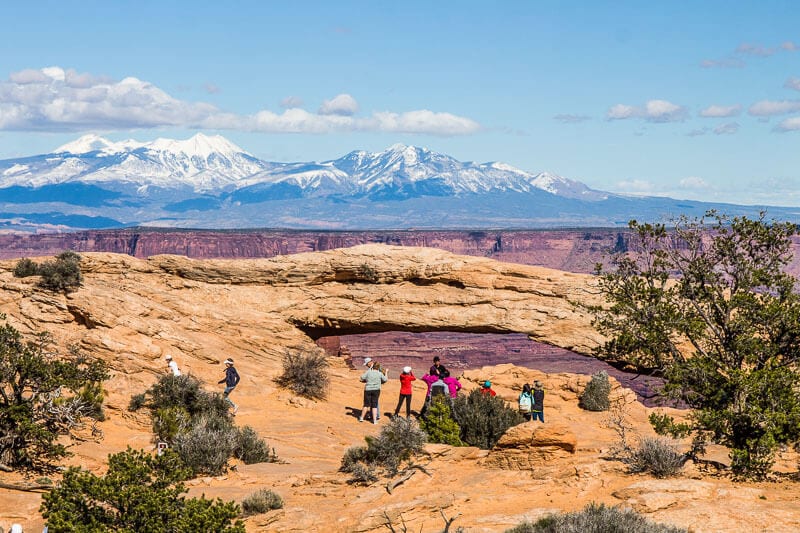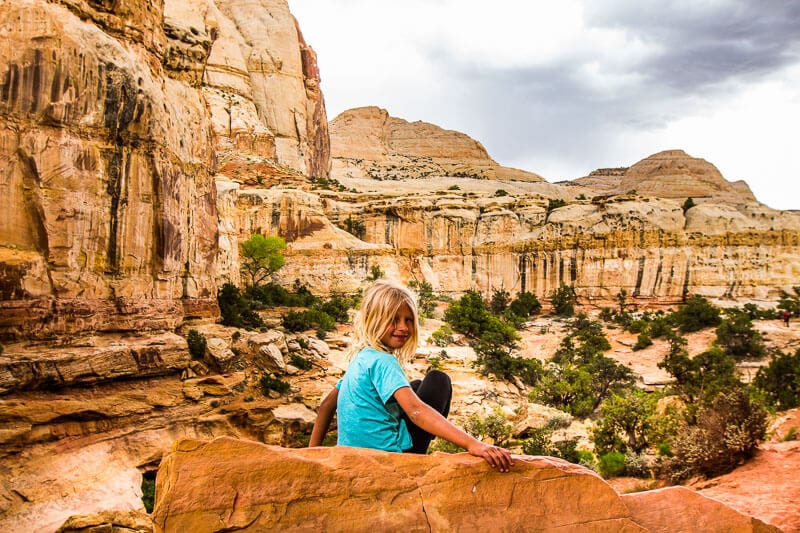
This post may contain affiliate links. We may receive a small commission, at no cost to you, if you make a purchase. Read Disclosure.
Located in South-Central Utah, is the encompassing and imposing Capitol Reef National Park, a long, otherworldly landscape that looks akin to something you’d see on Mars.
Also known as the Waterpocket Fold, this national park is famous for its golden sandstone canyons adorned with striking linear patterns, and craggy rock formations and natural rock pillars.
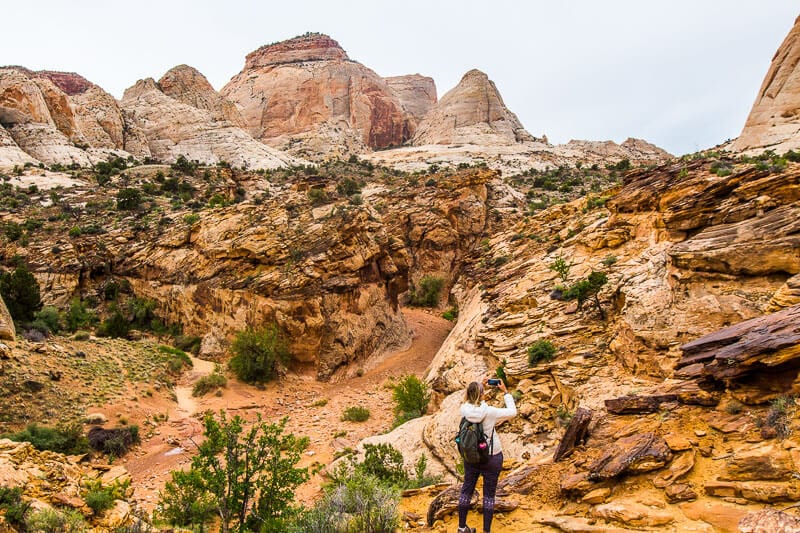
We spent three days exploring Capitol Reef National Park and we found it surprisingly action packed! It turns out, there is more things to do in Capitol Reef National Park than stare at rocks (although I could never get tired of staring at them!)
If you’re thinking of visiting Capitol Reef National Park and not sure what to do, in this guide we share our favorite sites in the park, including the best Capitol Reef hikes, top scenic drives, where to stay, how to get to the park, and much more.
What is so special about Capitol Reef National Park?
In native language, the area known as Capitol Reef means “the land of the sleeping rainbow.”
There is probably no more accurate poetic reference than this colorful playground protected for the benefit of all who wish to walk amongst its beauty.
The colors of the massive domes, towering cliffs, twisting canyons, arches and bridges change with the light, moving from deep reds to pastel pinks, sunburnt orange, soft yellows and whites.
Early explorers described it as an impassable reef of rock which gave (in part) to its current name: Capitol Reef National Park.

It is largely defined by the Waterpocket Fold, an enormous 100-mile-long wrinkle in the earth’s crust forming the backbone of the park.
This happened during a collision of two plates about 65 million years ago, resulting in the rock layers folded over the fault line instead of cracking.
Since then water has become the dominant erosive force shaping the beauty of the canyons, arches, cliffs, domes and bridges of Capitol Reef National Park Utah
Best Things To Do in Capitol Reef National Park
1. Cassidy Arch Hike
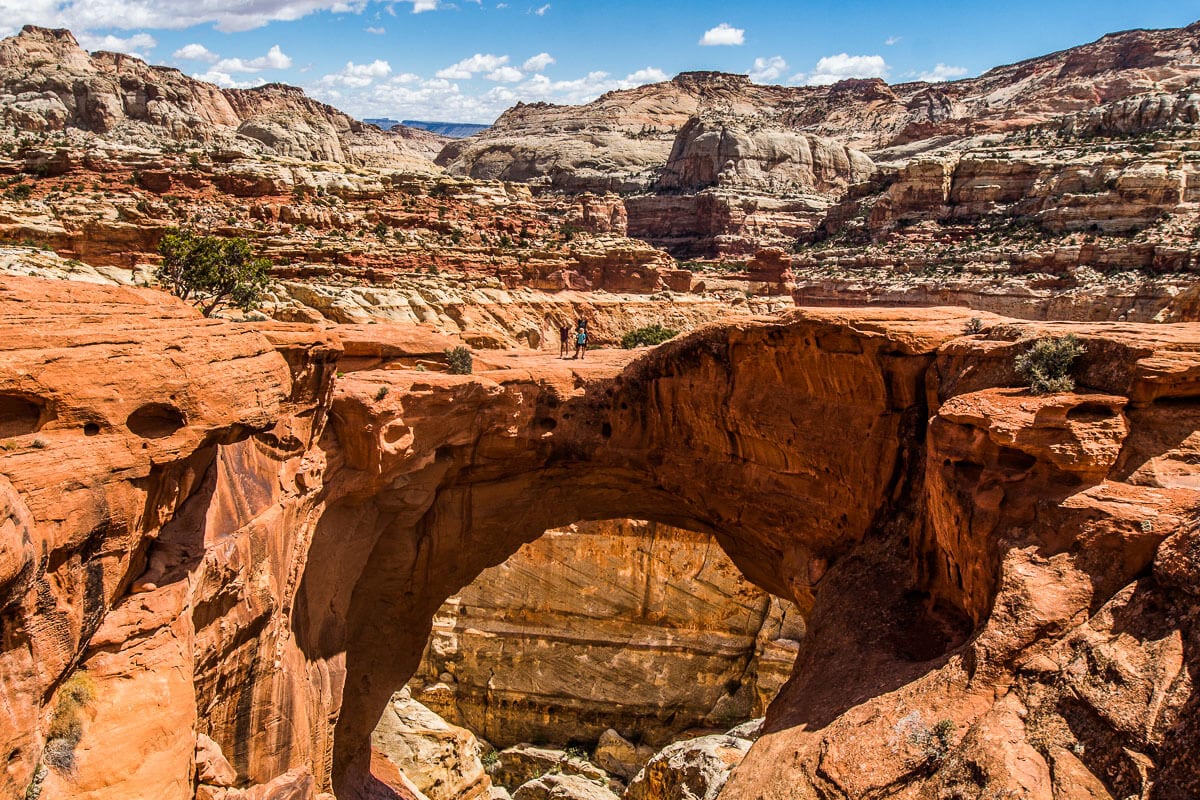
- Distance: 3.4 miles return
- Elevation Gain: 670 ft
- Difficulty: Strenuous
Named after the famous outlaw, Butch Cassidy, who is said to have hidden here, hiking to Cassidy Arch is one of the best Capitol Reef National Park hikes!
The Cassidy Arch Trail follows the edge of the canyon over slick rock to a natural arch and gorgeous views of the rainbow rock.
This trail is marked as strenuous. But it’s totally dependent on what you are used to as to whether you will find this challenging.
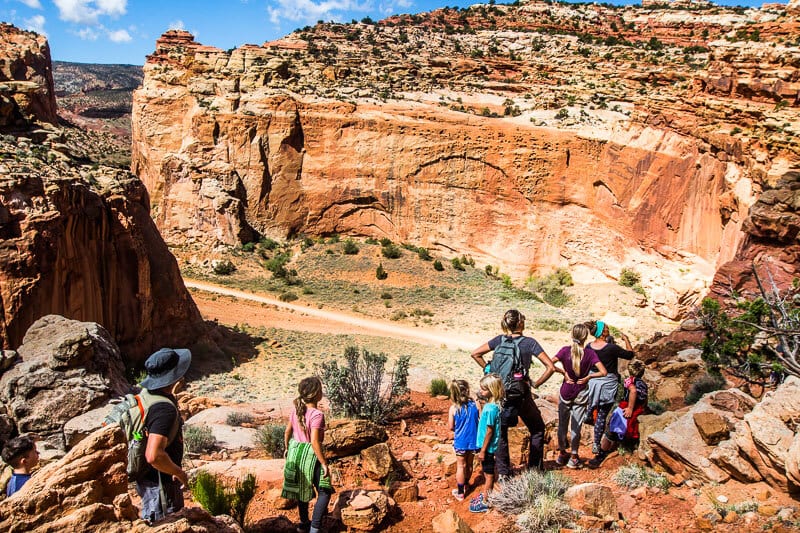
The elevation gain of 670 ft certainly got my heart, lungs and legs working, but we didn’t find it as strenuous as other walks we’ve done like The Lost Mine Trail in Big Bend Texas.
The youngest child in our group was six years old and she handled the walk like a superhero. All our kids did a fantastic job on this hike. I was most impressed with what great hikers they are.
There was a bit of whinging, but that is a normal day hiking with kids. They tend to complain but still have a great time.
2. Hickman Bridge Trail
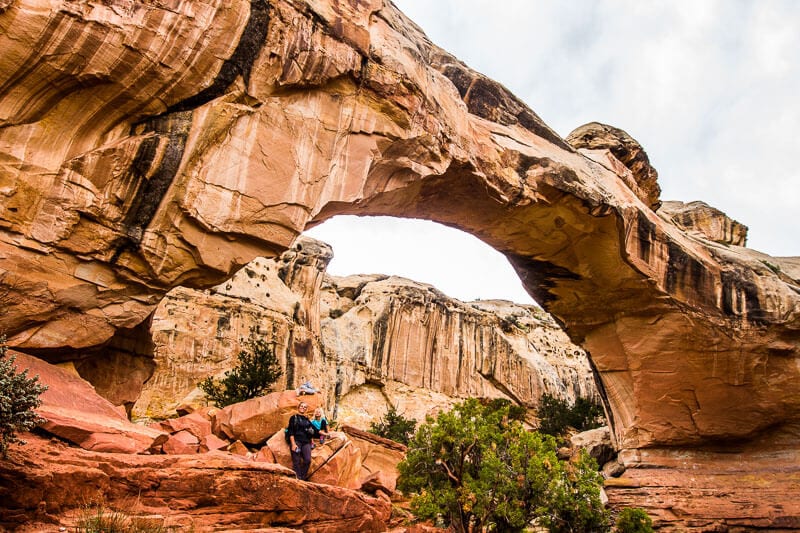
- Distance: 1.8 miles round trip
- Elevation Gain: 400 ft
- Difficulty: Moderate
What a gorgeous trail Hickman Bridge is and easy for any kind of traveler.
As soon as you hit the trail, you can see why it’s one of the best hikes in Capitol Reef National Park. The landscape is colorful, unique and diverse.
Despite being the most popular hike, we only saw a couple of other hikers on it!
The Hickman Bridge trail begins at the river and climbs up (elevation gain of 400ft in total) a scrubby mountain, before dipping into a sandy ravine with trees offering shade and little caves and waterfold pockets to climb over.
You then scramble over rocky terrain to views of 133-foot natural Hickman Bridge.
A loop trail runs underneath the bridge with very beautiful views back over the canyon you walked through.
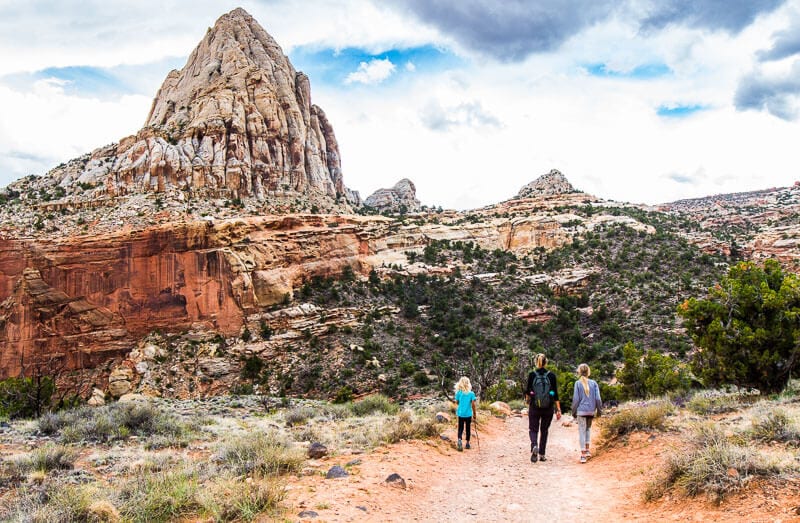
As you come round the loop and get ready to turn left be sure to veer off to the right (you won’t miss it), the scenery over the creek lined with green cottonwoods is spectacular and reminded me so much of Zion National Park.
You can see Capitol Dome on this trail. This Navajo sandstone feature was named for its resemblance to the US Capitol, which also inspired part of the park’s name.
One of the biggest treats came at the end of the hike as we were coming down the small hill.
Down below us next to the river were a herd of deer, an oddball bunch as their fur was molting and so very patchy.
Amongst them was a male with his short, furry antlers. They moved along the river eating grass and reaching up to the leaves to pull them down.
3. Grand Wash Trail
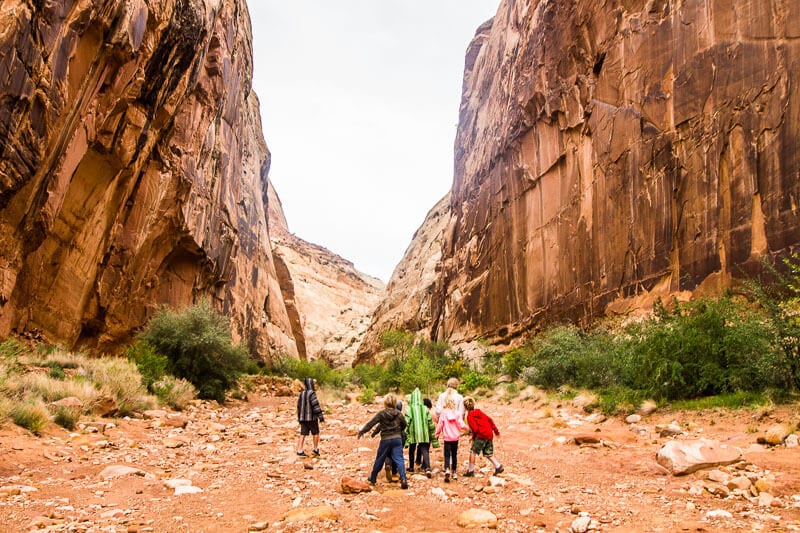
- Distance: 4.4 miles
- Elevation Gain: 200ft
- Difficulty: Easy
The Grand Wash trail in Capitol Reef was the longest but the easiest hike we did as it’s just a walk along the canyon floor.
Although it says the Grand Wash Trail has an elevation gain of 200 feet, we didn’t notice this at all.
You can hike 1.3 miles to The Narrows, which is the section where the canyon walls become sheer and close in on each other. I was expecting it to be like this the entire way, but it’s only narrow for a small section before opening up again
The trail takes you all the way to Highway 24. Unless someone is there to pick you up, you’ll have to hike back to your car at the trailhead.
This trailhead is the same spot as the Cassidy Arch. If you are fit and full of energy you could possibly do both hikes in the one day. But start early.
4. Capitol Gorge Trail
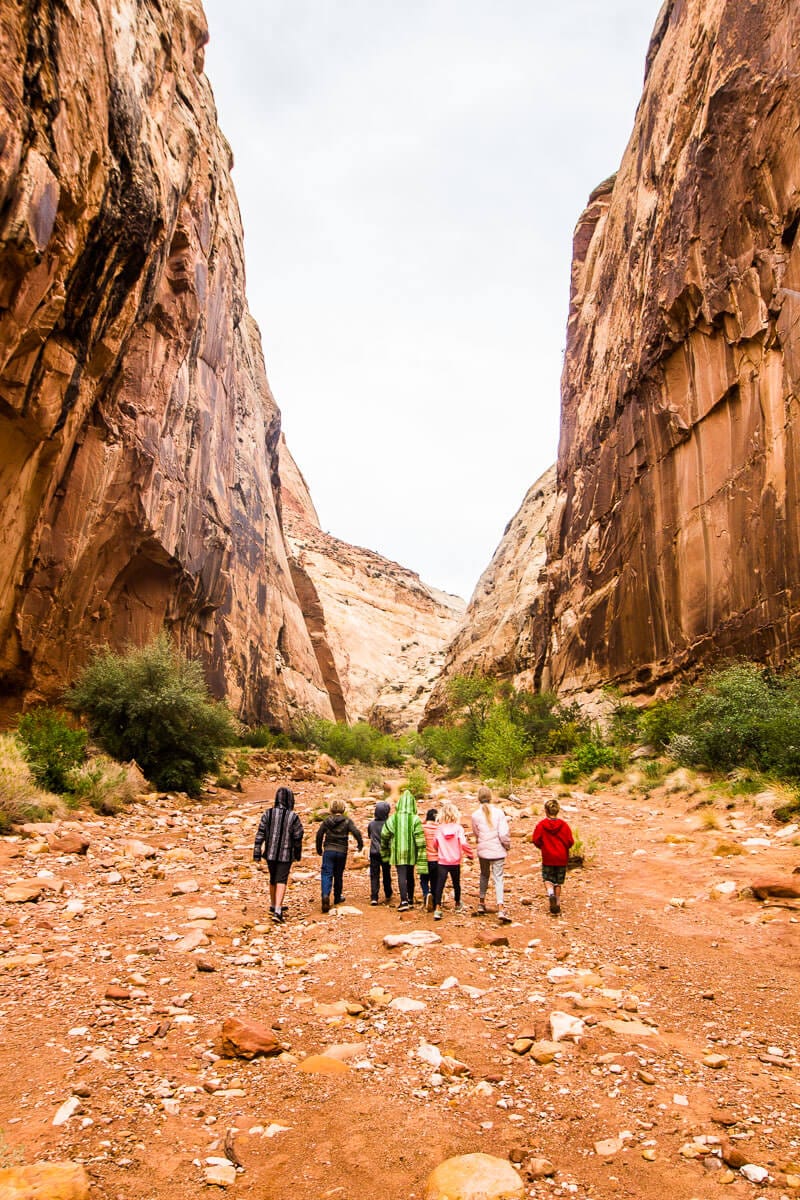
- Distance: 2 miles return
- Elevation Gain: 80 ft
- Difficulty: Easy
The Capitol Gorge Trail is another easy, short hike along the canyon floor, this time in the Capitol Gorge Wash area.
You can see petroglyphs panels along the way and at the end a short trail goes up to the see water pockets, called the Tanks. We kinda got lost and didn’t actually find them.
We were in an anxious hurry to walk back out as the rain started and you are advised to stay out of the washes if a thunderstorm is approaching due to flash flooding.
So with a bit more time and care you won’t get lost.
As of March 2024, this trail has been marked as closed. Check All Trails for information about its reopen.
Note: A vast majority of trails in most national parks, state parks, and federal reserves we’ve visited on our USA road trip have been very poorly marked. Download MapsMe, a free offline GPS, to find trails!
5. Goosenecks and Sunset Point Hike
- Distance: 2.4 miles out and back
- Elevation Gain: 84 meters
- Difficulty: Easy
If you want a quick hour-long walk for a sunset viewpoint, consider the Goosenecks and Sunset Point Hike.
You could just walk to Sunset Point (about 0.6 miles), but why not extend it for another gorgeous vista from Goosenecks.
This trail is always packed with photographers and sunset chasers! So get there early to find a decent sunset viewing spot.
6. Chimney Rock Loop
- Distance: 3.6 miles
- Elevation Gain: 242 meters
- Difficulty: Moderate
Chimney Rock Loop is a 3.6 miles return and listed as strenuous due to its 590 ft elevation gain, but if you’re a regular hiker, you won’t find it too challenging.
This hike is a popular one as it offers a wonderful panorama of the Waterpocket Fold from the top of the mesa along the edge of the fold.
One thing to note is the terrain of this trail poses some risk. Much of the ground has been eroded and there are some steep sections with long drops to one side.
The trail was closed in October 2024 to reconstruct some of it, so keep an eye on AllTrails to see when it might be open – hopefully this construction will help improve some of those dangerous areas!
7. Drive the 8 Mile Scenic Drive
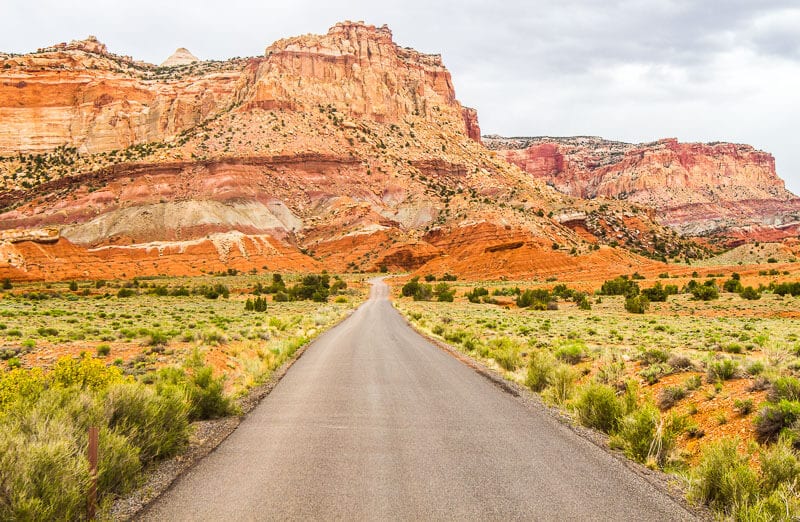
The Capitol Reef Scenic Drive (named simply that) winds through the heart of the park for 8 miles making allowing you to access many of the park’s top attractions and hiking trails.
You will not get tired of the red rock views in every direction on the park’s scenic drive. Sheer cliffs of every color and have been lifted, folded and carved into all kinds of shapes.
Let you and your kids imagination go wild in naming them.
Along this drive you can access the Grand Wash and Capitol Gorge, and the Fruita Historic District.
8. Highway 24 Scenic Drive
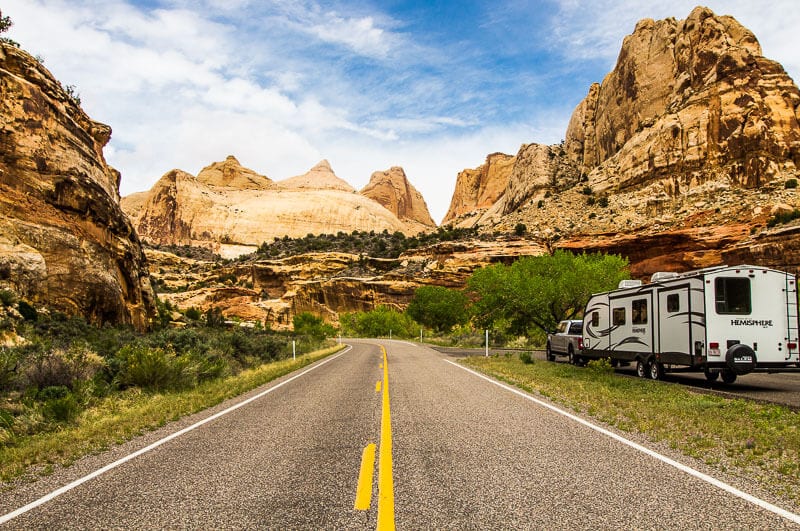
We entered Capitol Reef National Park Utah from Moab in the East on Highway 24.
Whilst Highway 12 starts just outside Capitol Reef NP and gets all the accolades as an All American Road, this highway also very good.
Take it slow, enjoy the views, and pull over for any of the many trails and attractions that begin off this highway.
It goes all the way through the national park and out to the nearest town of Torrey.
The landscape changes dramatically from one end to the other moving from mauve and white cliffs, to domes and towering peaks of yellow and pink, to deep red canyons walls.
9. Visit Cathedral Valley
The photos we saw of this area inspired us to visit. Monoliths and giant castle-like formations rise up from the desert floor.
Just a photograph of it seemed to hold the same spiritual and magnetic power that was present in the buttes and mesas during our visit to Monument Valley, our favorite place in the USA.
I overhead a woman telling her friend that it was her favorite of all the things to do in Utah!
We HAVE to do this. We discovered it was a 64 mile loop road only available for high clearance 4WD as there is a river crossing!
After our jeeping and 4WD adventures in Moab we felt more than confident to take the Beast (our F250) on this incredible adventure in Capitol Reef National Park.
The first part of the drive involves driving along a river and, unfortunately during our visit the area had experienced quite a bit of rain. This meant the adventure took on a higher risk we weren’t prepared to take on.
Utah is one of those states we’ll always return to for more adventures. You want to leave some activities to do on your return. Cathedral Valley is now at the top of our Utah bucket list!
10. Burr Trail Scenic Byway & Notom Bullfrog Road

The Burr Trail Road in the southern part of the park is spectacular!
This follows the Waterpocket fold and the colors as you look back on the rocks are extraordinary: pink, grey, chocolate, orange, yellow, and white
The Burr Trail Scenic Byway winds through a deep red slickrock canyon and rolling desert forest of orange and green.
It goes through the eastern portion off Grand-Staircase Escalante National Monument before reaching Capitol Reef National Park.
You’ll know when you’ve reached it you’ll see the jagged outcropping of bright rainbow colored rock that is so recognizable as the Waterpocket Fold and the stunning Capitol Reef.
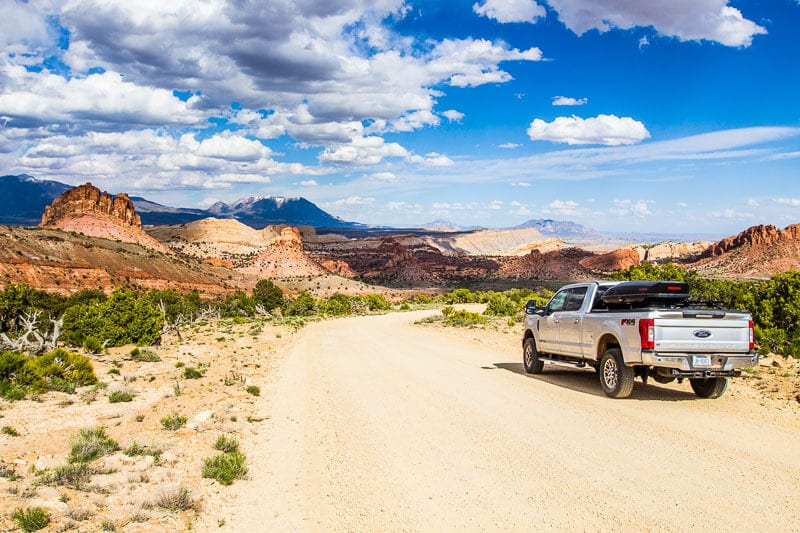
At the bottom of the switchbacks it meets with the Notom Road, which is a gravel road that runs from Highway 24 along the east side of Capitol Reef Utah.
You can follow it for as far as you like.
There are different hiking trails along the road. The Surprise Canyon was recommended to us but after our two massive hikes the previous days we decided to just have a resting scenic drive.
You can get into it coming from Highway 12 on the west and then go north on Notom Bullfrog road or come down from highway 24 in the north.
Both Highway 12 and Burr Trail Road were featured in our best USA scenic drives list.
11. Explore Fruita Historic District

In the 1880’s Mormons established the settlement of Fruita at the confluence of the Fremont River and Sulphur Creek.
They quickly learned how to live a self sufficient life building irrigation systems for their orchard and pastures. They had a quiet and social life here with their communities.
The historic Fruita District and Griffith Homestead was one of my favorite places to visit in Capitol Reef park and just sit and relax and watch the wildlife (deer often roam here).
After months in the American Southwest desert, it felt wonderful to finally be sitting under gigantic trees and green grass. This area makes Capitol Reef even more enticing and beautiful.
The Fruita Historic settlement includes the Fruita schoolhouse, blacksmith ship, the Gifford House store and museum and other buildings and features.
One of my favorite things to do in Capitol Reef National Park was to eat one of the gluten free raspberry cookies from the Gifford Homestead Store. It’s seriously one of the best cookies I’ve ever had.
It goes nicely with a cup of coffee and views of the horses grazing in the fields under the cottonwoods. And the pies are meant to be amazing too!
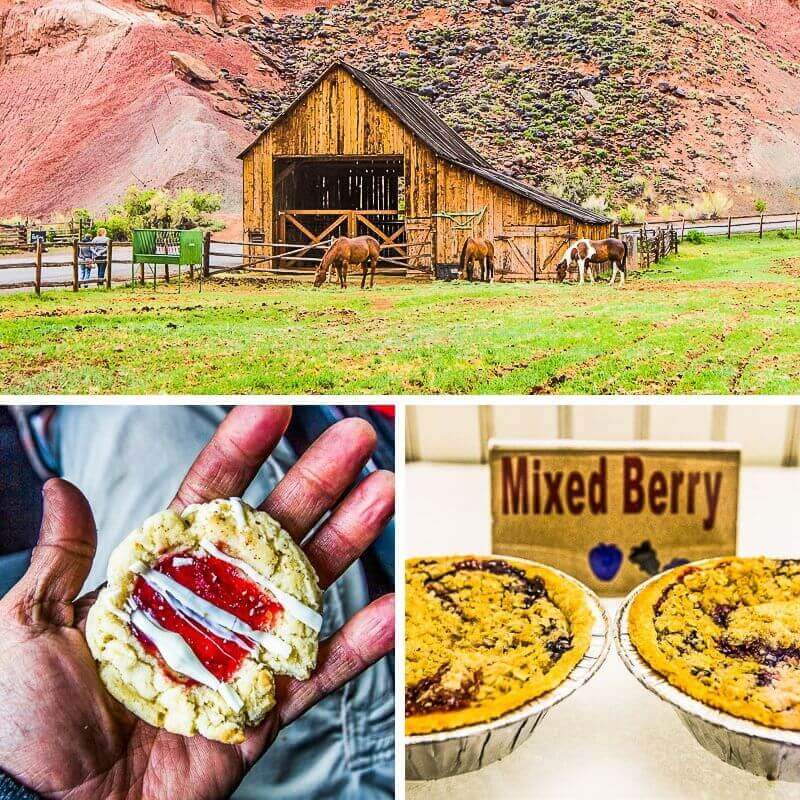
Down in the the valley, you’ll discover a verdant world of orchards and shady trees, horses and green grass.
Capitol Reef National Park Southern Utah maintains one of the largest historic orchards in the National Park Service with almost 3,000 trees. The orchards still produce fruit, although not in a commercial capacity.
The orchards have numerous fruit trees, such as apple, peach, cherry, pear, plum, apricot and almond trees. If you’re hungry and you spy a delicious piece of fruit on the tree, you’re welcome to pick it for a snack.
Fees will be charged if you wish to take any fruit home with you though.
I love how this area has been preserved in Capitol Reef.
12. Check out the Visitor Center
Stop in at the Capitol Reef National Park Visitor Center to learn more about the hikes at Capitol Reef National Park and other helpful information.
You can watch a short video on the history of the area, and geology of the park. It was quite interesting and the kids enjoyed it.
Here is where you want to pick up your Junior Ranger booklets and return them when finished to get the Junior Ranger badges.
13. Enroll the kids on a Junior Ranger Program
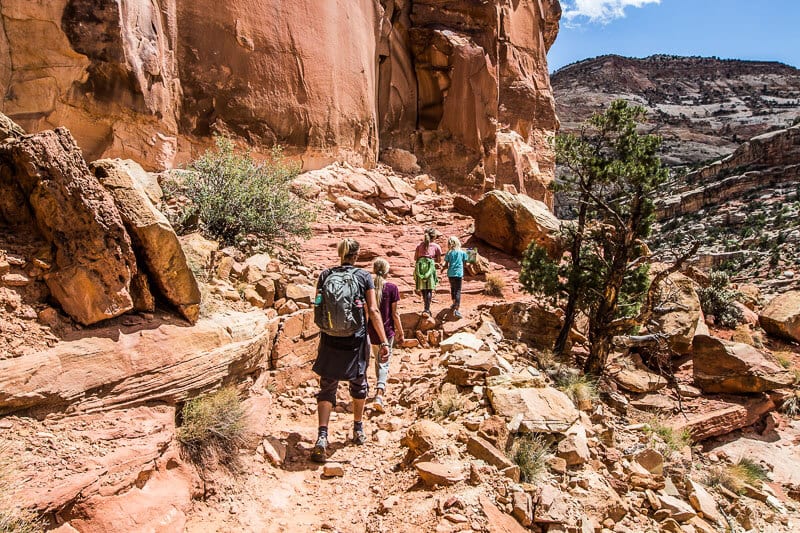
A must do with kids is the Junior Ranger Program.
Be sure to pick up your books for the kids at the Capitol Reef Visitor Center, do the activities, and get your badges at the end.
Part of the program requirement is to watch the 18-minute film in the visitor center to learn more about the par.
Best Time To Visit Capitol Reef National Park
The park is open year-round, but the best time to visit Capitol Reef country is October and November, when the weather is still warm from the summer but not yet affected by snow.
Similarly, March – June is a good time to visit for warm and dry weather, making them perfect months for hiking.
The monsoon season runs from July to September, with August being the wettest month. It’s best to avoid these months if possible.
Entrance Fees to Capitol Reef
There is no entry gate to pay your fee. It’s an honor system really.
It costs $20 per vehicle for a 7 day pass, or $10 without a vehicle. Remember your fees go towards protecting and maintaining the park.
There are free days throughout the year, usually on public holidays, so be sure to check the website before visiting to see if you are visiting on a free day.
We have an annual national park’s pass, which allows us to access all federal lands without paying the entrance fee.
It costs $80 for a year and is an absolute bargain if you intend on visiting a few parks within the year.
How long to visit Capitol Reef National Park?
The colors of Capitol Reef will fill you with an overwhelming sense of wonder and joy.
During our three days at Capitol Reef National Park we had some great adventures. You could make it happen in two days but those days would be long, and I could have easily stayed longer than three days and done a few more hikes.
It’s a gentle, quiet national park so if that is what you want, stay as long as you can.
You could do the above-mentioned hikes in Capitol Reef National Park in two days. They will probably be two long days though, but it can be done. I think three would be better.
If we had more time, we would have done Chimney Rock Hike at sunset and maybe one of the gentle river strolls.
Where to Stay in Capitol Reef National Park
The best way to experience Capitol Reef National Park is to camp. There aren’t a huge amount of options though, as there is only one serviced campground in the national park.
Located right next to the Gifford House is the Fruita Campground, which has 71 powered sites. It can be booked online here, and they accept reservations up to 6 months in advance. I highly recommend you get in early though, as it’s a popular campsite!
There are no hookups, although they do have water and a dump station. It’s a very pretty campsite and one I would love to stay in.
Boondocking (Free Camping)
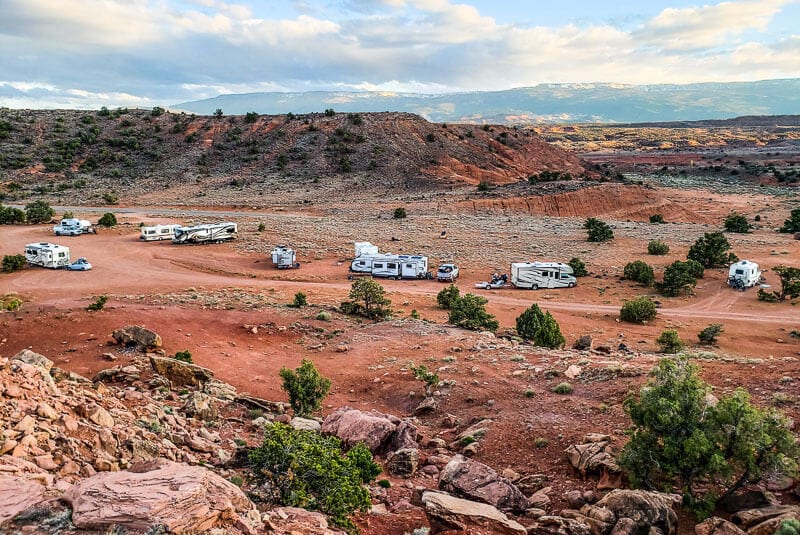
An alternative for those traveling with an RV, is to go boondocking. This is free RV camping, though there are restrictions on where you can park up for the night.
Although you cannot boondock inside the park, we found a lovely boondocking spot just outside the park’s west entrance and the town of Torrey.
You can find more boondocking spots, and free campsites, via The Dyrt here.
Hotels Near Capitol Reef National Park
There are no hotels inside Capitol Reef National Park, however there are places to stay along Utah State Route 24, the main road into the park.
If you don’t want to camp, the town of Torrey will be the closest place to stay near the park and offers a few restaurants and cafes. Here are some popular hotels in Torrey to consider:
Getting to Capitol Reef National Park
Capitol Reef NP is located in Southern Utah. It is quite a large area and is divided into three regions.
The Fruita District is where most visitors come as it’s the easiest to get to and explore. The other two areas involve more of an adventurous off-roading experience, so here is how you can get to the Fruita District…
The closest city to Capitol Reef National Park is Moab, which is about 2 hours and 10 minutes drive away (137 miles). To break up the journey, consider stopping at Goblin Valley on the way in from Moab.
The nearest airport is Bryce Canyon Airport (BCE), but you would most likely fly into Grand Junction Regional Airport in Colorado, because it operates more direct flights from major cities.
From Grand Junction Regional Airport, it’s a 3 hour drive via I-70 E/US-50 E and Utah State Route 24.
The entrance to Capitol Reef National Park is off Utah State Route 24, in the town of Torrey. You can find the entrance here.
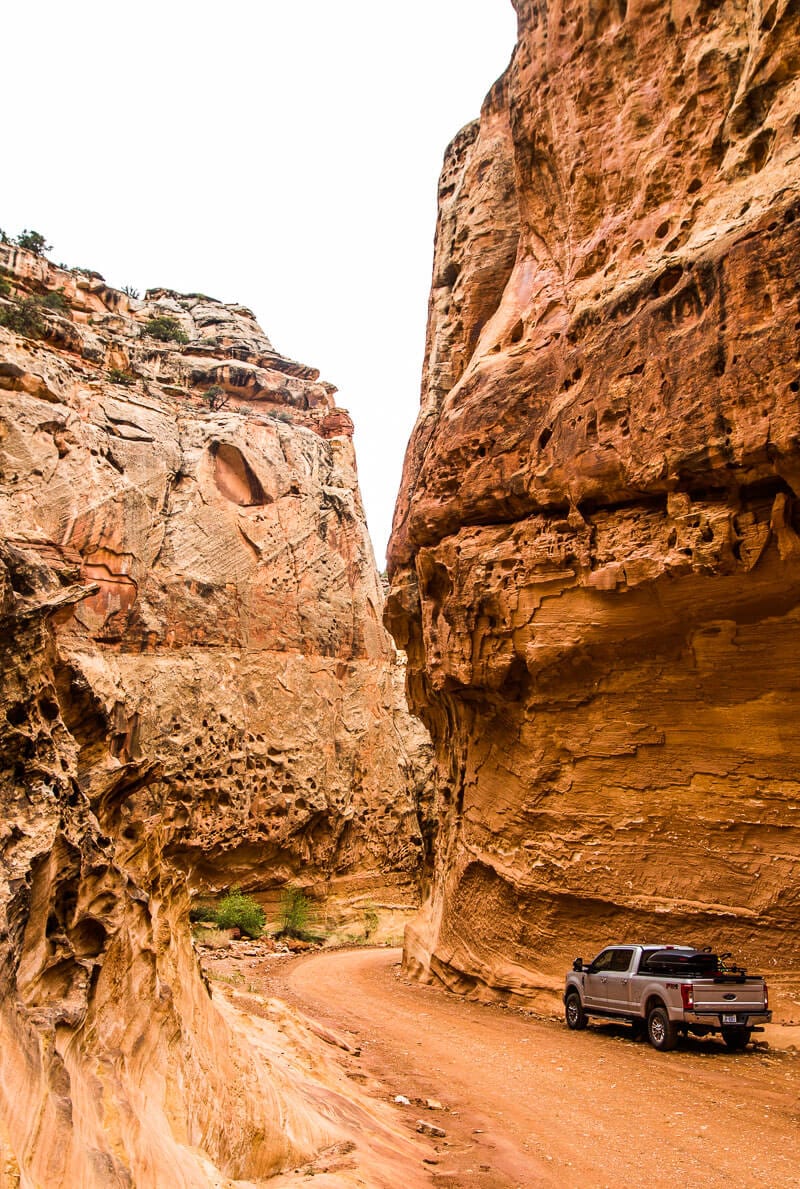
Car Rentals and RV Rentals
You do need a car to get around Capitol Reef National Park, so if you don’t have your own, check out these car rentals from Las Vegas.
If you’re planning on visiting more of Utah’s national parks and nature sites, consider an RV! Check out the unique RV rentals via RVshare here.
More Utah Travel Tips
Looking for more inspiration for visiting Utah? Start with these posts!
Pin To Save On Pinterest
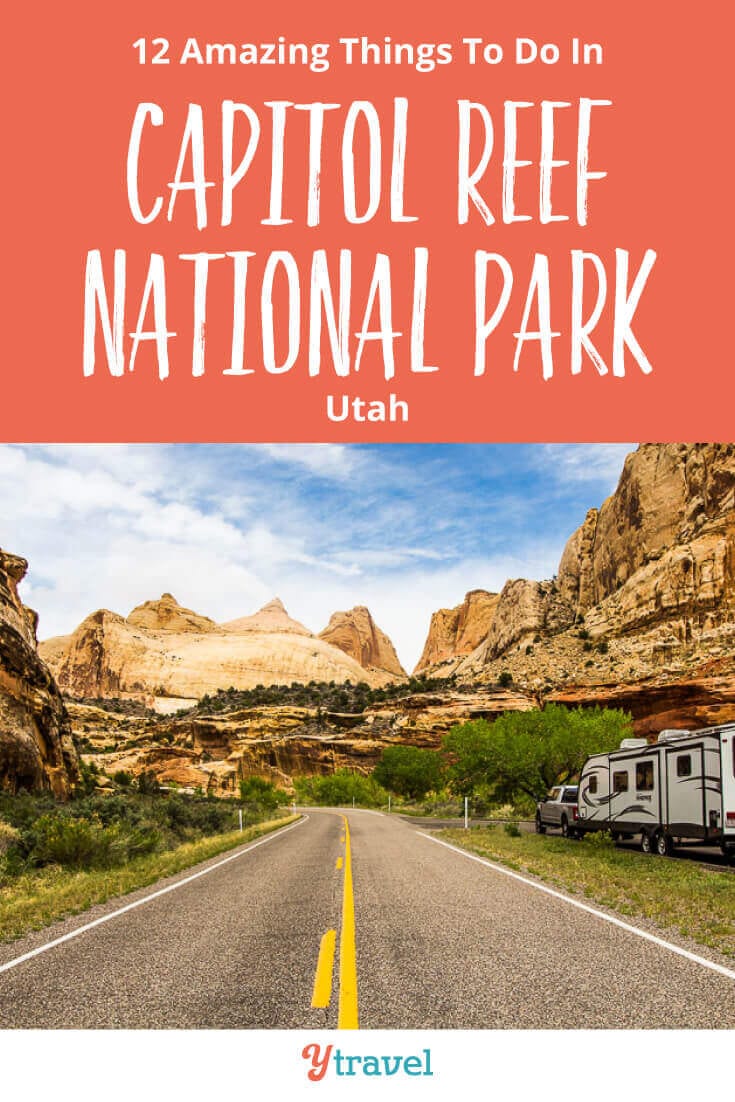
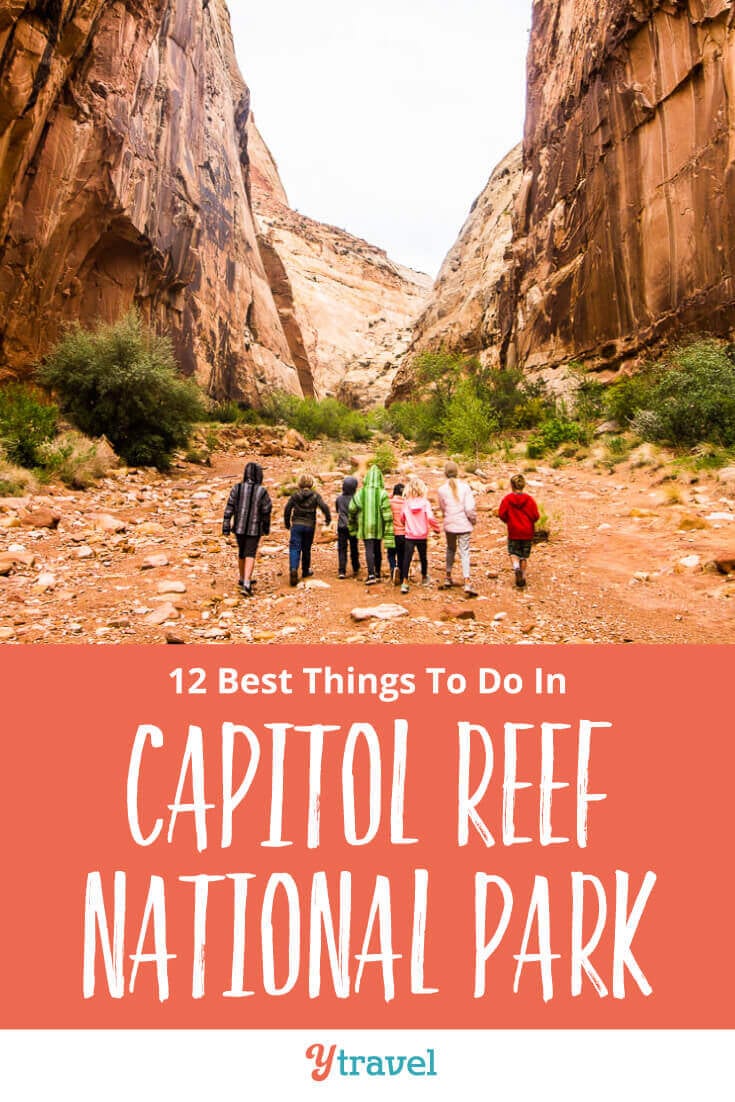
What are you most excited to do in Capitol Reef National Park? Let us know in the comments below.
Discover more from reviewer4you.com
Subscribe to get the latest posts to your email.
